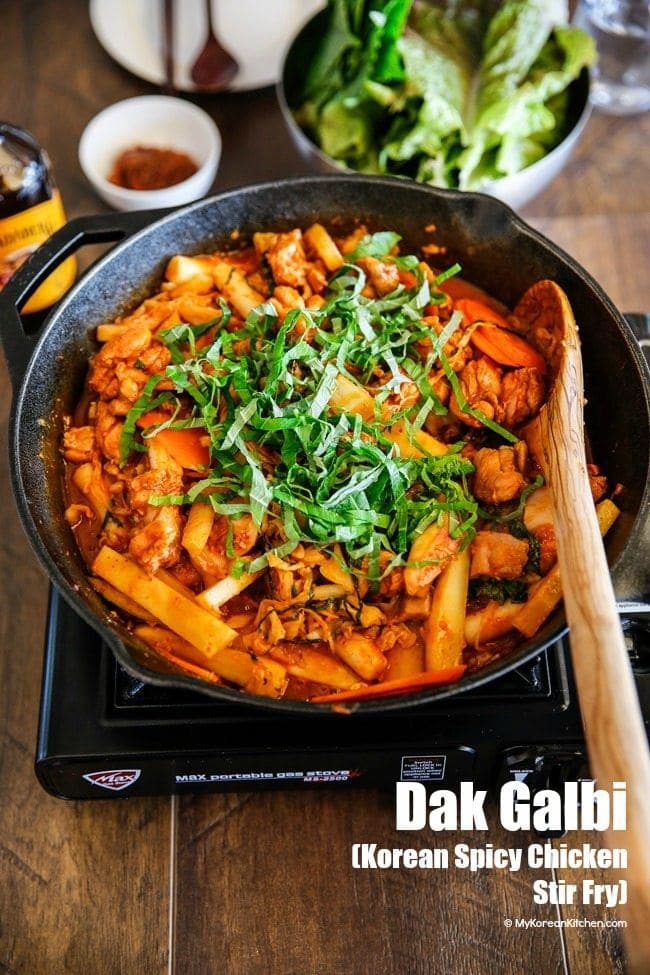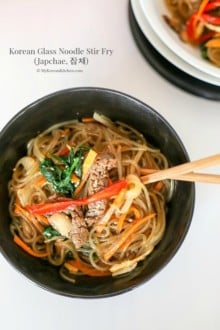How to make delicious and authentic ‘Chuncheon style dak galbi’ at home.
Dak galbi or dakgalbi (닭갈비, Korean spicy chicken stir fry) is by far my all time favorite Korean dish. That’s probably because growing up I had this meal a couple of times a week because my parents had owned a dak galbi restaurant for 10+ years.
And, I absolutely loved having it every time! I considered it as my privilege. 🙂
What is Dak galbi /Dakgalbi
Essentially, dak galbi / dakgalbi (닭갈비) is spicy chicken stir fried in a large pan, which is often a cast iron pan.
Chopped chicken is marinated in a mix of spicy Korean sauce then stir fried with rice cakes, sweet potatoes, green cabbage, and perilla leaves.
Dak galbi originated from Chuncheon (춘천), a beautiful lake city of Gangwon province in Korea. (It’s also the place where I spent the first 10 years of my life!)
At some restaurants, you can ask for bone-in chicken (slightly cheaper) or boneless chicken. I always preferred boneless chicken dak galbi since it’s more convenient to eat.
You can also see some restaurants selling chargrilled version (숯불닭갈비), which is another of my favorite dishes. This is cooked differently and results in a slightly different taste to regular dak galbi; You can use this grilled gochujang chicken recipe for that.
Nowadays, there are many variations on dak galbi one of which includes cheese dak galbi. You can dip the cooked dak galbi in melted cheese from the pan. Yum!
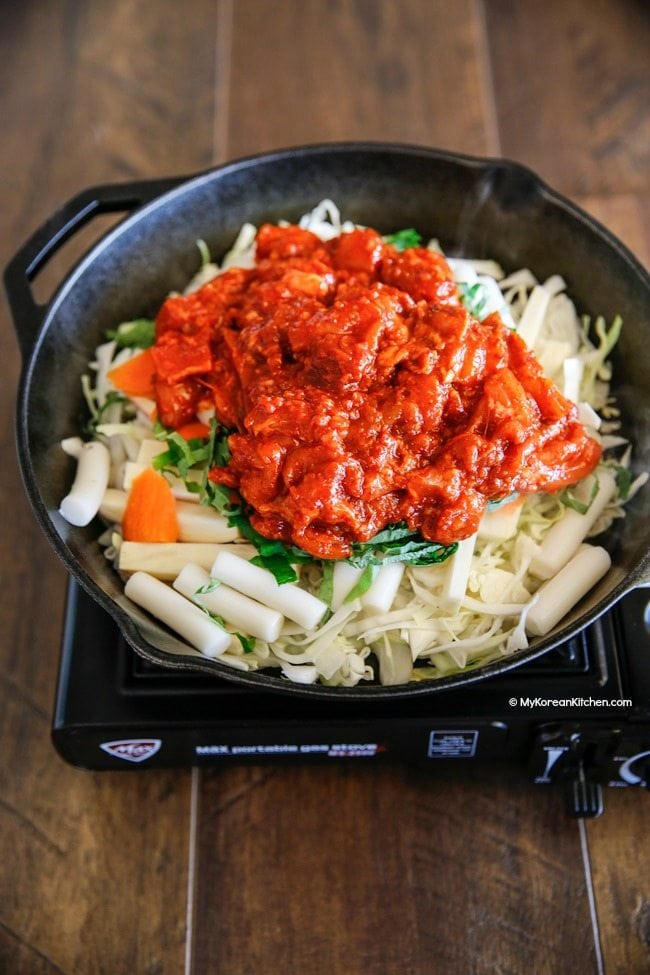
How to Make Dak Galbi, the Restaurant Way, at Home
- Typically, dak galbi is cooked and served in a large round cast iron pan at a restaurant. And I personally think it is essential that you eat it this way because it tastes so much better! Trust me! I use this cast iron skillet (12 inch) for my cooking and it’s just perfect.
- I love cooking dak galbi at the table (over the portable gas burner) so that we can eat it as things get ready. Typically, the cabbage and rice cakes cook the fastest and the sweet potato the last. If you were to wait until everything cooks then somethings could over cook as a result.
- Prepare some lettuce, perilla leaves, sliced garlic, ssamjang (spicy dipping sauce) to make a wrap just like you would with other Korean BBQ.
- When you are nearly finished the meal (make sure you leave some meat, vegetables and the sauce in the skillet), you can add some (cooked) udon noodles or rice and stir fry them. I typically use 1 cup of steamed rice, some chopped kimchi, a dash of sesame oil and some shredded seasoned seaweed. Some restaurants also crack an egg over the rice but I personally prefer without it. Also, I don’t normally add additional sauce to cook the noodles or rice, but if you want you could add some gochujang (about 1 Tbsp) or make extra marinade then add it.

The above photo shows how you should end the dak galbi meal. Anyway, I hope you enjoy my recipe!
FYI, a lot of people already commented that it’s the best dak galbi recipe they tried and the flavor is comparable to Chuncheon style dak galbi. I hope you try my recipe with some confidence. 🙂
Ingredients for Dak galbi, 2 to 3 servings
Main
- 500g /1.1 pounds chicken thigh fillets (you can use a whole chicken or chicken breast instead), cut into bite size pieces
- 1/2 medium sweet potato (180g/6.3 ounces), cut into long thick sticks (like English chips)
- 1/2 small carrot (60g/2.1 ounces), diagonally sliced
- 1/4 small cabbage (320g/0.7 pounds), shredded
- 10 Korean perilla leaves (35g/1.2 ounces), thinly sliced
- 18 fresh Korean rice cakes pieces (175g/ 6.1 ounces), separated, if you use pre-packaged rice cakes, separate them first then soak in warm water for 10 minutes before you use them.
- Some cooking oil (2 to 3 Tbsp) – I used rice bran oil
Marinade sauce
- 3 Tbsp gochujang (Korean chili paste)
- 2 Tbsp rice wine
- 1 Tbsp gochugaru (Korean chili flakes)
- 1 Tbsp soy sauce
- 1 Tbsp raw sugar
- 1 Tbsp minced garlic
- 1 tsp minced ginger
- 1 tsp Korean curry powder
- 1/2 small onion (35g/1.2 ounces), grated or minced
- A few sprinkles of ground black pepper
* 1 Tbsp = 15 ml
**If you want to learn more about Korean ingredients, check my essential Korean cooking ingredients list!
How to Make

1. Combine all the marinade ingredients in a bowl and mix them well. Pour the sauce over the chopped chicken and marinate for at least 30 mins. (Though I strongly recommend marinating it for at least 4 hrs, and if you can afford more time, for overnight for better flavored chicken. However if you are really short of time, 30 mins is OK.)
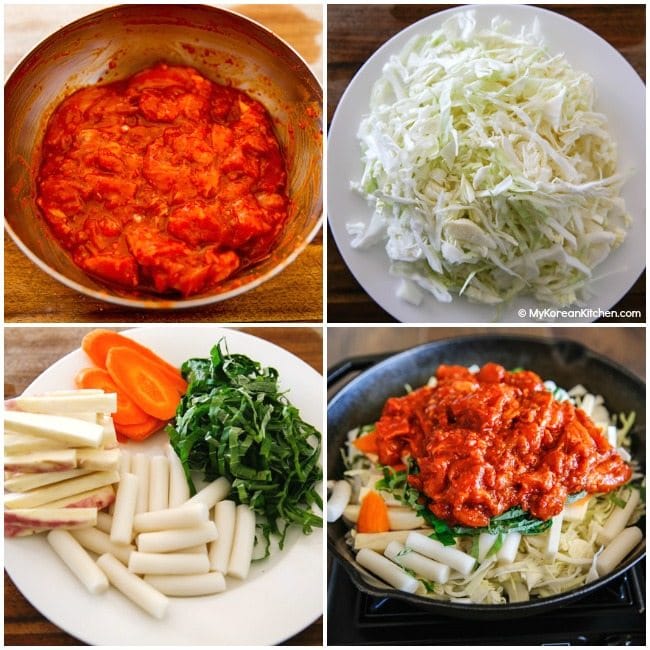
2. Preheat a large skillet on medium high heat and once heated add some cooking oil. Put all the vegetables and rice cakes into the skillet and add the meat on top. Cook them on medium high heat for 3-4 mins. Then reduce the heat to medium to medium low and cook further until all is cooked (about 10 – 15 mins). During cooking, stir often to avoid food sticking onto the pan. You can cover with a lid to speed up the cooking process.
3. Serve with rice and other Korean side dishes (optional).
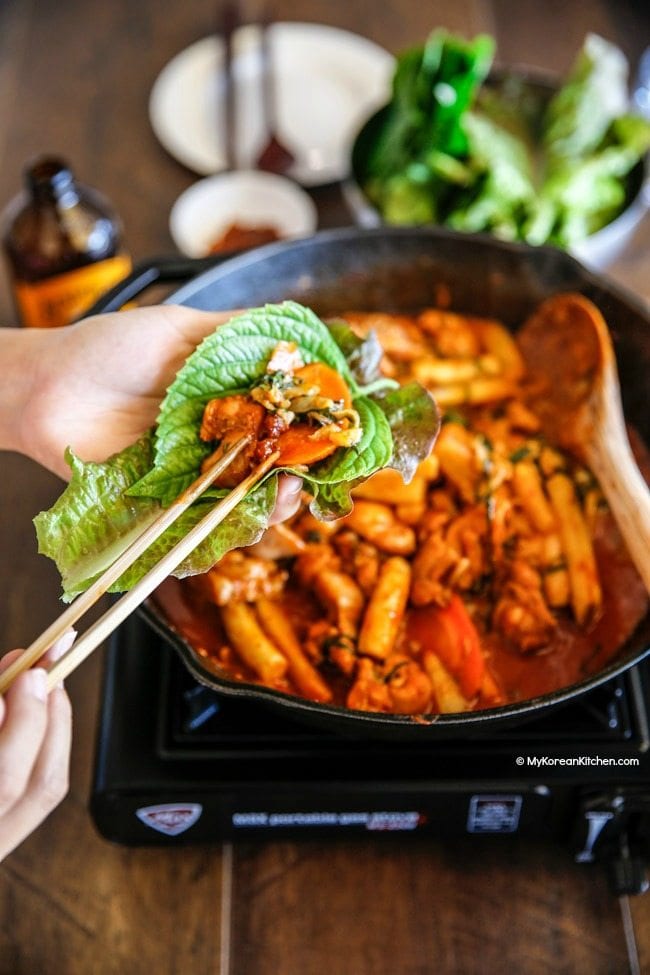
Love Korean food? Browse my other Korean recipes from here. And subscribe to my newsletter and follow along on Facebook, Pinterest and Instagram for all of the latest updates.

Dak Galbi (Korean Spicy Chicken Stir Fry)
Ingredients
Main
- 500 g chicken thigh fillets (1.1 pounds), you can use a whole chicken or chicken breast, cut into bite size pieces
- 1/2 sweet potato (180g / 6.3 ounces), cut into long thick sticks (like English chips)
- 1/2 carrot (60g / 2.1 ounces), diagonally sliced
- 1/4 cabbage (320g / 0.7 pounds), shredded
- 10 leaves Korean perilla (35g / 1.2 ounces), thinly sliced
- 18 pieces Korean rice cakes (175g / 6.1 ounces), separated, if you use pre-packaged rice cakes, separate them first then soak in warm water for 10 minutes before you use them
- Some cooking oil (2 to 3 Tbsp) - I used rice bran oil
Marinade Sauce
- 3 Tbsp gochujang Korean chili paste
- 2 Tbsp rice wine
- 1 Tbsp gochugaru Korean chili flakes
- 1 Tbsp soy sauce
- 1 Tbsp raw sugar
- 1 Tbsp minced garlic
- 1 tsp minced ginger
- 1 tsp Korean curry powder
- 1/2 onion (35g / 1.2 ounces), grated or minced
- Few sprinkles ground black pepper
Instructions
- Combine all the marinade ingredients in a bowl and mix them well. Pour the sauce over the chopped chicken and marinate for at least 30 mins. (Though I strongly recommend marinating it for at least 4 hrs, and if you can afford more time, for overnight for better flavored chicken. However if you are really short of time, 30 mins is OK.)
- Preheat a large skillet on medium high heat and once heated add some cooking oil. Put all the vegetables and rice cakes into the skillet and add the meat on top. Cook them on medium high heat for 3-4 mins. Then reduce the heat to medium to medium low and cook further until all is cooked (about 10 - 15 mins). During cooking, stir often to avoid food sticking onto the pan. You can cover with a lid to speed up the cooking process.
- Serve with rice and other Korean side dishes (optional)
Notes
** How to Make Dak Galbi, the Restaurant Way, at Home
- Typically, dak galbi is cooked and served in a large round cast iron pan at a restaurant. And I personally think it is essential that you eat it this way because it tastes so much better! Trust me! I use this cast iron skillet (12 inch) for my cooking and it's just perfect.
- I love cooking dak galbi at the table (over the portable gas burner) so that we can eat it as things get ready. Typically, the cabbage and rice cakes cook the fastest and the sweet potato the last. If you were to wait until everything cooks then somethings could over cook as a result.
- Prepare some lettuce, perilla leaves, sliced garlic, ssamjang (spicy dipping sauce) to make a wrap just like you would with other Korean BBQ.
- When you are nearly finished the meal (make sure you leave some meat, vegetables and the sauce in the skillet), you can add some (cooked) udon noodles or rice and stir fry them. I typically use 1 cup of steamed rice, some chopped kimchi, a dash of sesame oil and some shredded seasoned seaweed. Some restaurants also crack an egg over the rice but I personally prefer without it. Also, I don't normally add additional sauce to cook the noodles or rice, but if you want you could add some gochujang (about 1 Tbsp) or make extra marinade then add it.
Nutrition Info (per serving)
The nutrition information shown is an estimate provided by an online nutrition calculator. It should not be considered a substitute for a professional nutritionist’s advice.
